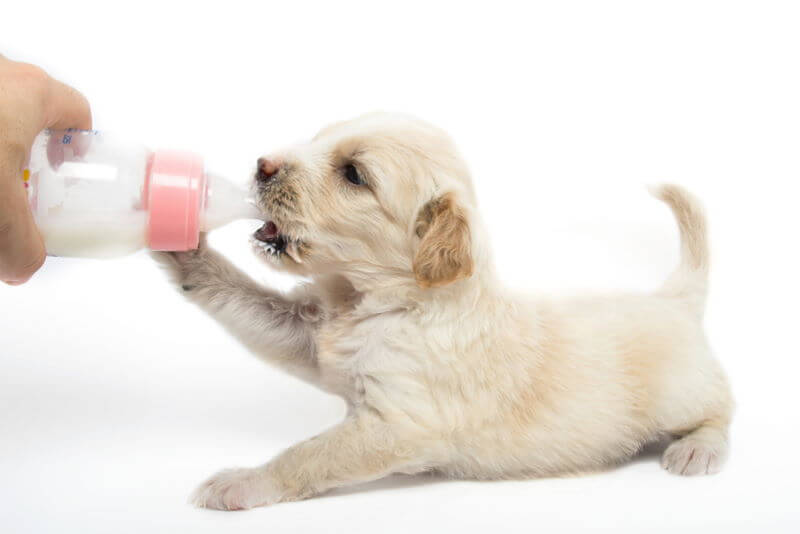For dog breeders, one of the most mind-boggling tenets of female pregnancy is lactation.
Most people are not fully aware of the ins and outs of milk production in dogs, particularly when it comes to the color of dog breast milk.
Your dog may produce yellowish, whitish, reddish, or even sticky milk.
It is imperative to understand what each of these colors means in order to provide the animal with the best possible care.
Herein, I will discuss all the possibilities in regard to dog breast milk color to ensure your nursing bitch lives a long and healthy life.
Let’s dive right in…
The Color of Dog Breast Milk

So, what color is a dog’s breast milk?
Well, as nature would have it, dog breast milk is white in color.
Studies show that dog milk is mostly made up of water.
Other constituents include proteins, energy, fat, dry matter, and sugar.
On average, dog breast milk contains:
- 3.8% Sugar
- 1.56% Lactose
- 22.7% Dry matter
- 7.5% Proteins
- 146 kcal Energy/100g
- 9.5% Fat
It is from these constituents that milk derives its white color.
Evidently, dog milk contains a smaller amount of lactose than other types of milk.
However, its protein content is superior. Canine caseins, α-LA, and β-LG are the main kind of proteins present in dog breast milk.
Together with phosphate and calcium, these proteins cluster to form minute specks referred to as micelles.
These particles refract light and scatter the beams, bringing about a white glow in milk.
So, the white color in milk is a product of science in that caseins micelles contort rays of light to create the liquid’s white appearance.
Generally, you can expect your bitch to produce this white fluid in various circumstances or stages of her life.
The most obvious instance is during lactation. Like any other female mammal, female dogs start producing milk at around the time of birth.
In most cases, their tits will start producing milk towards the end of the dogs’ 63-day gestation period.
For first-time pregnancies, the dog can start producing milk as early as 7 days prior to giving birth, while those that have previously given birth will start producing milk around 48 hours before birth.
Your dog could also start producing milk due to a false pregnancy.
This is a condition whereby the canine will exhibit pregnancy symptoms, such as nesting, nursing a toy, and milk production, whereas they are not actually pregnant.
This condition mostly occurs one and a half to three months after the animal’s estrous cycle as its hormones reach peak levels.
You may also want to check: Is Your Dog Still Pregnant? 45 Days Pregnant Dog Symptoms
Why is My Dog’s Milk Yellow?

You may notice that your dog’s milk is yellow, especially during the early stages of lactation.
Do not fret because this is a normal occurrence.
The yellow fluid is colostrums—transitional milk produced within the first 24-36 hours of giving birth.
It is yellow and thick, almost resembling a runny egg yolk.
Colostrum is rich in vitamins, basic nutrients, and electrolytes. It is also rich in antibodies which are designed to help boost the puppies’ immune systems.
Ideally, this yellowish milk is a means for the mother to pass on her immunity to the young ones, commonly referred to as passive immunity
On the flip side, yellowish milk should be a cause of concern if the dog exhibits other worrying symptoms such as reduced appetite, swollen breasts (mostly those nearest to the groin), and fever.
These symptoms suggest acute septic mastitis, a condition caused by agitation to the nipples as puppies suckle, thereby allowing bacterial infestation in this region.
Mastitis could also be brought about by unhygienic living conditions or galactostasis.
The latter refers to a milk overload in the breast which in turn causes severe enlargement.
Mastitis should be treated using prescribed antibiotics.
In other cases, the dog’s nipples can produce a dark brown liquid.
This is a sign of bleeding, albeit not in the ordinary dark red hue.
It could be that the mastitis is causing this bleeding.
However, it could also be that the dog has a tumor.
The only way to tell these causes apart is by keenly examining the dog’s symptoms.
While mastitis features swollen breasts with some discomfort, a tumor will come in the form of a painless lump within the mammary gland region.
Make sure to visit your vet immediately for appropriate diagnosis and treatment.
Is Dog Milk Sticky?
In both the ulcerated and inflamed mammary glands cases, the dog’s yellowish or reddish discharge will have a thick consistency.
This is because the milk likely contains huge traces of blood or pus.
Therefore, expect the milk to be unusually thick and sticky.
However, a healthy lactating dog will produce free-flowing milk without this thick consistency.
Parting Thoughts
In conclusion, dog breast milk should be white just as is the case with other mammals.
To ensure healthy lactation for your dog, you could consider providing her with sufficient fluids, such as clean water, chicken broth, almond milk, or goat milk.
A balanced diet is also paramount to healthy lactation.
Make sure to include a lot of leafy vegetables, meaty bones, and fatty fish in its meals.
Lastly, ensure the breeding area is clean to prevent any bacterial infections
However, healthy lactation is not always a guarantee.
It is also possible for the dog to produce a thick, yellowish discharge. This is a sign of septic mastitis.
Inversely, a reddish-brown discharge signifies a tumor.
The devil is in the details.
Critically examine your dog’s symptoms to get an idea of what might be ailing her and seek veterinary advice immediately.
As an Amazon Associate, we may receive a small commission from qualifying purchases but at no extra cost to you. Learn more. Amazon and the Amazon logo are trademarks of Amazon.com, Inc, or its affiliates.

